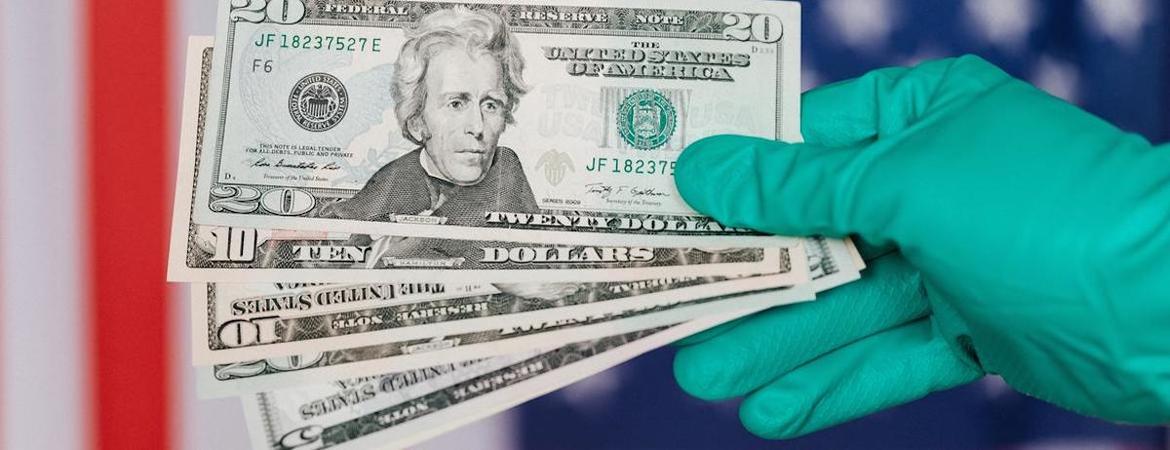
March 8, President Biden was set to sign into law the American Rescue Plan, a $1.9 trillion economic stimulus that will provide $1,400 checks to millions of low- and middle-income Americans, new child tax benefits, and extend unemployment payments. It also includes a restaurant rescue fund, money for reopening schools, and funding for state and local governments, among other items. As many among us await stimulus checks, we asked Jana Grittersova, a UCR economist and associate professor of political science, to weigh in on the implications of the stimulus. Grittersova is a former banker and economist at the European Commission.
Most of us have trouble fathoming $1.9 trillion dollars. Given that the federal budget last year was about $4.5 trillion, we wonder how we can afford the stimulus. What’s the likely long-term trade-off from this magnitude of spending?
Some consider President Biden’s strategy for revival of the U.S. economy the most radical departure from U.S. economic policies since Reagan’s liberal reforms in the 1980s.
Most economists agree that additional stimulus is needed. However, there has been a fierce debate over its scale and size, up to 13% of GDP, including the stimulus signed into law by President Trump past December. This disagreement over the merits and the affordability of the stimulus package is exemplified by the debate between two prominent economists — Larry Summers, Harvard professor and a former Treasury secretary in the Obama administration and Paul Krugman, the economics Nobel laureate. Summers expressed concern that Biden’s stimulus plan is at least three times larger than necessary, particularly when the U.S. cumulative budget deficit will be quickly approaching record World War II levels. The stimulus will increase the risk of overheating and inflationary pressures, with consequences for the dollar and financial stability. For Krugman, the top priority is the immediate welfare of a population badly hurt by the crisis. He argues that not passing a large recovery package in the environment of weak economic performance could increase economic anxiety resulting in lower spending and investments by firms and households, which would further weaken the economy.
A proposal by Jason Furman, who chaired Obama’s Council of Economic Advisers, suggests that the stimulus should be contingent on the pace of recovery. This may offer a reasonable compromise solution. In other words, it would automatically carry on with assistance if the economy continues to be weak but would also allow for ending aid if the economy starts to grow faster than expected.
Will paying off the stimulus money be achieved solely through expanding the deficit further, or is there a reasonable expectation of revenue to offset it?
While fiscal stimulus is an appropriate response to the pandemic, it creates debt, which will be paid back by future generations. It is therefore important to ensure a return to that spending. If successful, the stimulus package should boost economic growth that will result in generating substantial tax revenues for not only for the federal government but also for states and municipalities.
However, there are some additional considerations. If governments consider long-term increases in fiscal spending, for instance on health and social care to build a post-COVID resilient system, they may need to consider raising taxes. Admittedly, this concern might be more acute for countries that do not have the same access to finance as the U.S., which also benefits from being an issuer of the global reserve currency.
Might the new debt threaten public investment in things such as infrastructure and renewable energy?
Again, there is a disagreement on this issue. The critics of the Biden’s stimulus program argue that its focus should be on public investment and “build back better.” While the stimulus should address relief needs, there should be room for public investment. For Summers, it is better to lock in public investment now than to lock in spending power of households. For years, Summers warned about “secular stagnation,” the view that advanced economies were stuck in a to a state of little or no economic growth and needed more stimulus. His concern is, however, that the stimulus package will leave us less space to respond to secular stagnation.
But the proponents of the stimulus program are optimistic that it will be completed by the time the infrastructure plan will be implemented. More importantly, the stimulus can create space for a greater and greener growth and help expand our industrial base. The focus, proponents argue, should be instead on the proper sequencing of the measures. That is, we need to implement the rescue plan (since the economy is more than 11 million jobs short of where it should be) before focusing on infrastructure, energy, and climate initiatives.
The current environment of low interest rates provides fiscal space to increase spending. But if interest rates increase due to inflationary pressures resulting from the stimulus, it may be harder to implement the economic plan focusing on infrastructure and renewable energy.
Critics say inflation is one of the primary risks of the stimulus. Is it a risk? And under what circumstances would the stimulus create inflation?
A prominent French economist and former chief economist of the IMF, Olivier Blanchard, who is known to be supportive of higher public debt, argued that Biden’s stimulus program could increase the risk of “inflationary collision.” There is a concern that historically, every time inflation accelerated, the Federal Reserve stepped in to tame it, increased interest rates, recession followed, and unemployment increased. The lesson of the 1970s and 1980s is that reducing inflation expectations is costly. Krugman is not worried about the impact of a record-breaking stimulus package on inflation, instead he is worried about policies being excessively “constrained by the fear of a ‘70s repeat.”
At the moment, we see no significant resurgence in inflation expectations. Inflation predictions are known for their uncertain nature, though. As a former central banker, I am always concerned about the risk of inflation. While inflation around 3% or even temporarily higher is not worrisome, the Fed would have to take measures if there were sustained inflationary pressures and increase interest rates, which can cause a recession and unemployment. There are additional considerations. If a large one-off fiscal stimulus to deal with an unprecedented shock, such as the COVID-19 stimulus, is terminated at some clearly determined time, it is unlikely that there will be long-term consequences for inflation expectations. But large fiscal stimuli that will not be an exception but the norm in the post-COVID era could lead to more serious concerns about surge in inflation.
Furthermore, any rise in inflation in the U.S. can have international ramifications. For instance, it may dissuade European conservative leaders from adopting the fiscal stimulus to finance Europe’s recovery from the pandemic. And a big fiscal stimulus is perhaps even more important for Europe, where the economic impact of the pandemic has been worse and the recovery weaker than in the U.S.
Ultimately, policymakers have to decide what risks they are willing to take to help millions of people badly affected by the pandemic, particularly low-income families and the unemployed.
Historically, does government stimulus increase consumer spending? Or do people tend to save the money?
We are in the world of excess savings that need to be spent or invested. American households currently save about 12%-14% of their income, but this is a much lower saving rate than in Germany, Japan, or China. While Americans are now saving more, there is a notable demographic divide: higher-income households are saving much more and use their savings to repay their debt. These households were able to keep their jobs and benefitted from higher stock prices and a housing boom. The economy needs these people to spend, book vacations, go to restaurants, and so on. By contrast, households in the bottom 40% of the income distribution have hardly any savings. Empirical research has established that the poor households have a high propensity to consume, therefore a program directed at increasing incomes of this part of the population can help revitalize the economy. But the stimulus checks are a one-off payment to help households deal with a crisis, not a permanent wage increase, thus people may not spend them as freely.
History fosters some optimism, though. Many are drawing historical parallels between the coronavirus pandemic and the 1918 Spanish flu, which claimed at least 50 million lives. After the Great War and the influenza pandemic, American consumers, eager for comeback, started to massively spend their savings.
The Obama administration's relief package in 2009 provided $700 billion to offset about half of the budget shortfall from The Great Recession. Did it go far enough? What lessons can we learn from the 2008 stimulus?
The American Recovery and Reinvestment Act of 2009 ended up costing $831 billion. But a consensus has emerged that the economic growth would have been stronger if the post-2008 stimulus package had been much bigger. In the decade after the 2008 financial crisis, the U.S. economy did not succeed in returning to the pre-crisis output levels.
It has been argued that the main rationale for “going big” is the evidence from the post-2008 period that countries have greater room for economic growth and higher employment rates without inflation increasing. We know that Democrats were badly hurt by low stimulus after the 2008 global credit crisis. President Obama was criticized for wasting his political capital by doing too little rather than too much. We also all know that the checks to eligible adult population are popular. Biden’s stimulus plan may be the result of a fragile political balance in a divided Congress.
However, any policy must be assessed by its appropriateness to the circumstances, while considering its risks and benefits. The coronavirus crisis is a unique crisis; it is uneasy to compare it with the financial crisis.
President Biden recently said of the stimulus package: “It’s big and it’s bold, and it’s a real answer to the crisis we’re in.” Is it big and bold enough to stimulate the economy? Is the president correct in saying the danger of insufficient stimulus is greater than excessive stimulus?
“Act big” is the new slogan of the Biden administration. There is a need for large fiscal spending to ensure a full recovery from the COVID-19 crisis. The Federal Reserve is on board. Its chairman Jerome Powell argued for the need for “patiently accommodative” monetary policy, a signal that the central bank is not planning to increase interest rates in the near future.
But some studies have shown that accommodative monetary policy has boosted asset prices, especially those of stocks and houses. Because the rich people own more assets than poor households, the wealth inequality in the U.S. may widen even further. Additional expansionary policies may lead to another wave of asset-price appreciation and wealth inequality increase.
It is thus important to assess what a stimulus of 9% of national income will accomplish. Janet Yellen, Treasury secretary, reassured us that that Biden’s plan could bring the economy back to full employment before the end of 2021. We should also think about the international ramifications of this stimulus. International organizations, such as the IMF and OECD, advised countries to loosen their fiscal policies to help the recovery, but not on the scale proposed by the U.S. government. The success of the fiscal stimulus is of immense importance. As Harvard economist Kenneth Rogoff said: “If it goes wrong for the U.S., it goes wrong for everybody.”




